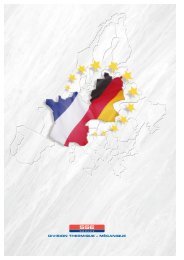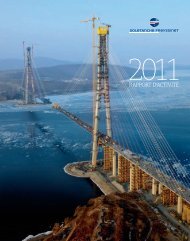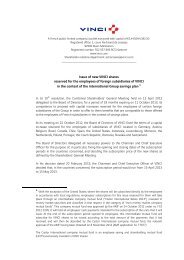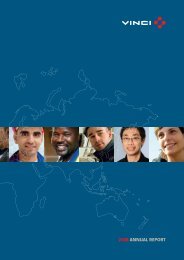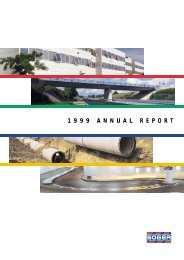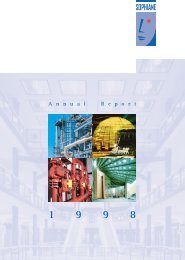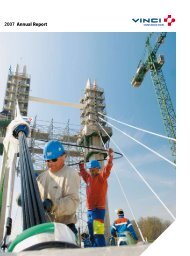VINCI - 2005 annual report
VINCI - 2005 annual report
VINCI - 2005 annual report
Create successful ePaper yourself
Turn your PDF publications into a flip-book with our unique Google optimized e-Paper software.
3.4. INTERNAL AUDIT<br />
The internal audit department’s role is to draw up and distribute the holding<br />
company’s general procedures and to supervise the improvement of<br />
procedures in place in divisions, while ensuring that they are adapted to<br />
the Group’s situation and organisation, in compliance with the demands<br />
of the Financial Security Act. It also organises the meetings of the <strong>VINCI</strong><br />
Risk Committee charged with examining and authorising the acceptance<br />
of new business that exceeds certain thresholds (see paragraph 4.1).<br />
It records and follows up the Risk Committee’s decisions. Lastly, it un-<br />
REPORT OF THE CHAIRMAN<br />
dertakes specifi c assignments requested either by the Group’s General or<br />
Financial Management or the Management of the various business lines.<br />
The internal audit department works with business lines’ internal audit<br />
staff, with whom it undertakes joint assignments, personnel seconded<br />
for this purpose by the operational department concerned and personnel<br />
from certain of the holding company’s functional departments.<br />
3.5. THE ROLE OF THE HOLDING COMPANY IN RELATION TO THE BUSINESS LINES<br />
The holding company has staff restricted to some 150 people, suited<br />
to the Group’s decentralised structure. The holding company’s various<br />
functional departments have to ensure that the Group’s rules and procedures<br />
and General Management’s decisions are applied. Furthermore,<br />
and depending on needs expressed, these departments advise business<br />
lines on technical matters without interfering in operational decisions,<br />
which remain the business lines’ responsibility.<br />
4. THE MAIN INTERNAL CONTROL PROCEDURES<br />
The main procedures described below are common to all companies in the Group. There are specifi c procedures within each business line, in particular<br />
for the monitoring of projects and forecasting of results, especially for contracts spanning several years.<br />
4.1. PROCEDURES FOR AUTHORISATION OF NEW BUSINESS: THE <strong>VINCI</strong> RISK<br />
COMMITTEE<br />
Strict procedures are applied before orders are accepted. All replies to<br />
tenders that exceed set thresholds must be authorised in accordance with<br />
the Group’s procedures.<br />
The <strong>VINCI</strong> Risk Committee has to assess:<br />
– acquisitions and disposals of activities;<br />
– the terms and conditions of submitting offers and in particular the<br />
related technical, legal and fi nancial commitments;<br />
– all transactions relating to property development, concessions or longterm<br />
commitments, including the associated fi nancing.<br />
This procedure covers all public- or private-sector business whatever the<br />
manner in which the enterprise is contacted (e.g. directly, or through an<br />
invitation to tender, project organisation, a public-private partnership or<br />
a concession), both in France and in foreign countries.<br />
It applies to all contracts of an amount exceeding a threshold set in the<br />
procedures; this amount relates to the operation in question taking all<br />
lots together, whatever the share obtained by Group entities.<br />
Other thresholds, lower than those necessitating consideration by the<br />
Risk Committee, trigger submission of prior information to <strong>VINCI</strong> General<br />
Management on an alert form. Lastly, under the system of delegation<br />
and sub-delegation in place, other thresholds trigger a requirement for a<br />
formal agreement from the business line’s General Management, under<br />
the procedure specifi c to and defi ned by each business line.<br />
The Risk Committee’s objective is to examine business that, particularly<br />
because of its size, fi nancial structure, location or specifi c nature, bears a<br />
special risk; other factors may be adopted as criteria for examination, in<br />
particular regarding tenders that involve a large technical risk.<br />
Submission to the Risk Committee constitutes formalisation of the commitment<br />
made by the manager of the subsidiary in question as to the<br />
expected level of profi t on the project presented.<br />
The Committee is usually composed of the Chief Executive Offi cer or<br />
Co-Chief Operating Offi cer, the Chief Financial Offi cer, and the Chief<br />
Audit Offi cer (for the holding company); the Chairman of the business<br />
line concerned and representatives from the operational staff (the general<br />
manager, project manager, design offi ce manager, etc.) and functional<br />
departments (legal, insurance, fi nance, etc.) of the company presenting<br />
the project. Moreover, the composition of the Risk Committee may be<br />
altered depending on the purpose of its meeting (e.g. examination of<br />
property transactions, acquisitions of companies, or long-term concessions<br />
contracts).<br />
Submission to the Risk Committee is obligatory whenever the thresholds<br />
determined on the basis of the business line and the nature of the business<br />
are exceeded.<br />
The holding company’s Risk Committee, in its various confi gurations,<br />
met on average three times a week in <strong>2005</strong>.<br />
171




